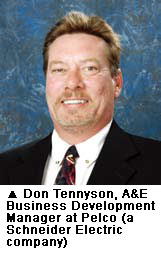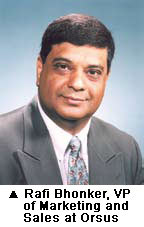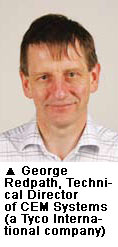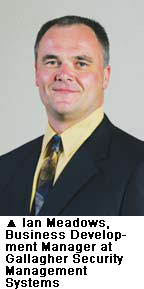Airports are a country's gates. They must effectively manage and control security to ensure not only traveler and worker safety, but also national security. A&S takes a look at how airports are secured, along with their current challenges and future trends.
Airports are a country's gates. They must effectively manage and control security to ensure not only traveler and worker safety, but also national security. A&S takes a look at how airports are secured, along with their current challenges and future trends.
US airports are fenced or secured with locking doors to restrict access to authorized personnel, with video covering the whole area, said Don Tennyson, A&E Business Development Manager at Pelco (a Schneider Electric company). Abnormal behavior, unauthorized access and human traffic flow are monitored by surveillance.
At an airport, three areas require high-level security — landside before check-in, airside after boarding and the apron by the runway.
High-Risk Areas
 US airports are fenced or secured with locking doors to restrict access to authorized personnel, with video covering the whole area, said Don Tennyson, A&E Business Development Manager at Pelco (a Schneider Electric company). Abnormal behavior, unauthorized access and human traffic flow are monitored by surveillance.
US airports are fenced or secured with locking doors to restrict access to authorized personnel, with video covering the whole area, said Don Tennyson, A&E Business Development Manager at Pelco (a Schneider Electric company). Abnormal behavior, unauthorized access and human traffic flow are monitored by surveillance.
At an airport, three areas require high-level security — landside before check-in, airside after boarding and the apron by the runway.
Landside
Historically the landside area has offered free access to the public, but landside incidents such as the 2007 attempted suicide attack at Glasgow Airport have raised the threat level, said George Redpath, Technical Director of CEM Systems (a Tyco International company). The Glasgow attack involved a propane-laden car driven through the airport's doors, resulting in measures such as restricted vehicular access.
Nonsterile sections, such as crowded check-in areas, are  vulnerable and require security monitoring. These areas are watched for unusual behavior that could threaten safety, such as abandoned bags containing explosives or emergency exit doors forced open in sensitive areas.
vulnerable and require security monitoring. These areas are watched for unusual behavior that could threaten safety, such as abandoned bags containing explosives or emergency exit doors forced open in sensitive areas.
Cameras are used by the Transportation Security Administration at portals, Tennyson said. The US Immigration and Customs Enforcement (ICE) has its own screening system at borders, while airport police use cameras shared with security operations center.
Public areas, such as parking lots, are accessible and require close watch. Automatic license plate recognition (ALPR) is used for airports, which is tied to revenue control systems for parking, said Manon Blouin, Product Manager of AutoVu IP License Plate Recognition Solution at Genetec. As parking is one of the main revenue sources for an airport, it is a priority.
Mobile ALPR can log where vehicles are in a parking facility if there are no cameras at the entry/exit lanes. With such solution, airports can reduce costs with fewer cameras, as two mobile cameras cost less than multiple lanes with multiple cameras, Blouin said. Customers can also track where parked cars are.
Airside
The airside area is located beyond check-in, restricted to passengers and staff.  Passengers are required to identify themselves and undergo a rigorous check of their person and belongings. This is to prevent incidents within the airport and during the flight. Airport staff must show staff credentials with associated background checks, and be searched before entering the airside area.
Passengers are required to identify themselves and undergo a rigorous check of their person and belongings. This is to prevent incidents within the airport and during the flight. Airport staff must show staff credentials with associated background checks, and be searched before entering the airside area.
Three more zones exist within airside: departure channels and lounges, arrival channels and retail. Airports must ensure arriving and departing passengers cannot mingle, before the arriving passengers are screened.
The retail areas and employee lounges are rented to retailers and airline companies, who are not managed by airport security, Wong said. Private DVR systems typically monitor these areas.
Passengers are required to identify themselves and undergo a rigorous check of their person and belongings. This is to prevent incidents both within the airport and during the flight. Airport staff must show staff credentials with associated background checks, and also be searched before entering the airside area.
Apron
A third risk-area is at the apron with baggage handling. It is restricted to staff who work in close proximity to aircraft, requiring access control and screening.
Some large airports have more than 1,000 secure doors, such as London's  Heathrow Airport Terminal 5, with a database of 100,000 staff. Airports usually have multiple buildings that must be accessible to airport operators and statutory bodies, such as immigration, customs and police.
Heathrow Airport Terminal 5, with a database of 100,000 staff. Airports usually have multiple buildings that must be accessible to airport operators and statutory bodies, such as immigration, customs and police.
Iris recognition can manage employees crossing from landside to airside, said Mohammed Murad, VP of Global Sales and Business Development, Iris Technology Division, LG Electronics USA. It is one of the most accurate biometric identifiers, while processing people quickly.
The baggage area is fully automated after Sept. 11. "Megapixel cameras watch both personnel and luggage, while vandal-resistant cameras embedded with image tampering analytics trigger alarms when security events occur," Wong said.
The cargo center, catering center and air traffic control must be safeguarded for the public's safety and airport operations, said Mervyn Cheah, CTO at ST Electronics. Stringent access control measures stop unauthorized people from gaining entry to secured areas, thus preventing sabotage and terrorist attacks.
Perimeter
Generally, automated detection and surveillance systems  are deployed for unmanned areas. Remote monitoring is performed by communication networks, Cheah said.
are deployed for unmanned areas. Remote monitoring is performed by communication networks, Cheah said.
The largest unmanned area in an airport is its perimeter, as terminals are no longer the weakest link. "Airports have miles of perimeter fencing that protesters can climb through or drive in with vehicles," said Jason Burger, Sales and Marketing Manager of Navtech Radar. "Radar technology with fences helps to warn security personnel of incidents in advance and enables airports to utilize manned security only when needed.”
With fuel prices increasing, airports must secure their fuel storage facilities, said Ian Meadows, Business Development Manager at Gallagher Security Management Systems. Airports are investing in perimeter systems that reduce fuel theft.
Design
Airport planning must balance two seemingly conflicting requirements: it must  maximize security and yet enhance the travel experience, Redpath said. This means that security must be thorough yet nonintrusive when possible. Installers need to make sure security elements are inconspicuous to the casual eye.
maximize security and yet enhance the travel experience, Redpath said. This means that security must be thorough yet nonintrusive when possible. Installers need to make sure security elements are inconspicuous to the casual eye.
Network infrastructure plays an important role in airport planning. Cabling determines what solutions the airport deploys, as older airports with coaxial systems are restricted to analog systems, Wong said. Most new airports have Cat 6 cabling installed as a more future-proof system, which can deploy analog and IP solutions.
Sufficient bandwidth must be considered in the planning phase. Sites that use fiber optics need to specify what cables to install, such as single mode or multimode, Wong said.
User requirements and dataflow need to be analyzed before the installation of security systems. Since airport security generates large amounts of data, it must balance centralized and distributed architecture, Redpath said.
Integration
Security systems in airports are mission critical,  manned around the clock by trained personnel, Cheah said. Security can be integrated with centralized facility management or operational monitoring systems that track passenger flows and baggage handling.
manned around the clock by trained personnel, Cheah said. Security can be integrated with centralized facility management or operational monitoring systems that track passenger flows and baggage handling.
For areas requiring remote management, WAN and LAN are preferred, Cheah said. IP-enabled edge devices are also favored, since they tap into the airport's IT infrastructure with minimal or no installation of cables.
Security and information systems are integrated widely in airports. They are shared throughout the airport's system, with the exception of ICE, which has its own system, Tennyson said.
Situational management integrates and correlates information from various security systems, providing a unified view. False alarms can be minimized, making security responses more efficient, Bhonker said.
Therefore, due to budget constraints, only a handful of airports are fully equipped with digital solutions. Most airport security systems are still deployed over conventional communication networks, with front-end computers on the IT network as the key interface, said Cheah.Hybrid solutions bridge the gap between digital and analog. For example, the Sydney airport is currently the most advanced airport in Australia, Wong said. There are about 1,500 cameras — mostly networked — securing the public areas. The other analog cameras are connected through encoders, resulting in a hybrid video solution.
Challenges
The most common problem for airport security is  management by many parties, such as the government and different airlines. They often have different brands of equipment installed which are not integrated, Wong said. This becomes a problem for video analytics, as it is hard to track people who pass through different monitoring areas.
management by many parties, such as the government and different airlines. They often have different brands of equipment installed which are not integrated, Wong said. This becomes a problem for video analytics, as it is hard to track people who pass through different monitoring areas.
It is difficult to have an open solution with products from several vendors. If a camera captured an incident at a terminal gate, the control room personnel will find it difficult to locate without seamless integration of the many cameras at the gate, Wong said.
Future Outlook
Advanced access control management and network surveillance coupled with video analytics are the driving forces for airport automation, Cheah said. More sophisticated security technologies will be introduced.
Video analytics will become more popular, although the number of airports deploying intelligent video is small, Tennyson said.
Lower costs are another trend. "As equipment prices drop to acceptable thresholds in the near future, we can expect more airports to be 'fully' automated, making security breaches less likely," Cheah said.